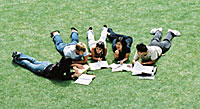| Legal Theory - LAWS8320 |
|
|||||||||||||||||||||||||||||||||||||||||||

Description The course is composed of two parts. In part one we discuss a number of basic notions associated with contemporary legal philosophy. These include - the nature of legal analysis, the separation of law from other areas of social life, the character of legal positivism, the role of the legal decision-maker, legal practice as an interpretive activity, the character of moral judgment, the difference in moral theory between the right and the good, liberalism as a political theory and its opponents, and liberalism's attitude to rights and to cultural difference.
In part two we apply some of these ideas to a number of 'problems' in contemporary legal practice. Just which problems varies from semester to semester but typical areas of study would be - human rights in East Asia, the legal response to cultural diversity, feminism and difference, legal responsibility, punishment, rights and judicial power, citizenship, the character of legal decision-making. Note/s: If taken as an elective, it is LAWS2331 (UOC8) |
||||||||||||||||||||||||||||||||||||||||||||

| Contacts | Library | myUNSW | WebCT |